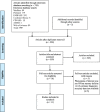Diagnostic utility of patient history, clinical examination and screening tool data to identify neuropathic pain in low back related leg pain: a systematic review and narrative synthesis
- PMID: 32778086
- PMCID: PMC7419221
- DOI: 10.1186/s12891-020-03436-6
Diagnostic utility of patient history, clinical examination and screening tool data to identify neuropathic pain in low back related leg pain: a systematic review and narrative synthesis
Abstract
Background: Low back-related leg pain (LBLP) is a challenge for healthcare providers to manage. Neuropathic pain (NP) is highly prevalent in presentations of LBLP and an accurate diagnosis of NP in LBLP is essential to ensure appropriate intervention. In the absence of a gold standard, the objective of this systematic review was to evaluate the diagnostic utility of patient history, clinical examination and screening tool data for identifying NP in LBLP.
Methods: This systematic review is reported in line with PRISMA and followed a pre-defined and published protocol. CINAHL, EMBASE, MEDLINE, Web of Science, Cochrane Library, AMED, Pedro and PubMed databases, key journals and the grey literature were searched from inception to 31 July 2019. Eligible studies included any study design reporting primary diagnostic data on the diagnostic utility of patient history, clinical examination or screening tool data to identify NP in LBLP, in an adult population. Two independent reviewers searched information sources, assessed risk of bias (QUADAS-2) and used GRADE to assess overall quality of evidence.
Results: From 762 studies, 11 studies were included. Nine studies out of the 11 were at risk of bias. Moderate level evidence supports a cluster of eight signs (age, duration of disease, paroxysmal pain, pain worse in leg than back, typical dermatomal distribution, worse on coughing/sneezing/straining, finger to floor distance and paresis) for diagnosing lumbosacral nerve root compression, demonstrating moderate/high sensitivity (72%) and specificity (80%) values. Moderate level evidence supports the use of the StEP tool for diagnosing lumbar radicular pain, demonstrating high sensitivity (92%) and specificity (97%) values.
Conclusions: Overall low-moderate level evidence supports the diagnostic utility of patient history, clinical examination and screening tool data to identify NP in LBLP. The weak evidence base is largely due to methodological flaws and indirectness regarding applicability of the included studies. The most promising diagnostic tools include a cluster of 8 patient history/clinical examination signs and the StEP tool. Low risk of bias and high level of evidence diagnostic utility studies are needed, in order for stronger recommendations to be made.
Keywords: Diagnosis; Low back related leg pain; Neuropathic pain; Systematic review.
Conflict of interest statement
None declared.
Figures
Similar articles
-
Diagnostic utility of patient history, clinical examination and screening tool data to identify neuropathic pain in low back-related leg pain: protocol for a systematic review.BMJ Open. 2019 Nov 24;9(11):e033187. doi: 10.1136/bmjopen-2019-033187. BMJ Open. 2019. PMID: 31767596 Free PMC article.
-
Diagnostic utility of diagnostic investigations to identify neuropathic pain in low back-related leg pain: protocol for a systematic review.BMJ Open. 2024 Jan 29;14(1):e078392. doi: 10.1136/bmjopen-2023-078392. BMJ Open. 2024. PMID: 38286684 Free PMC article.
-
The utility of diagnostic selective nerve root blocks in the management of patients with lumbar radiculopathy: a systematic review.BMJ Open. 2019 Apr 20;9(4):e025790. doi: 10.1136/bmjopen-2018-025790. BMJ Open. 2019. PMID: 31005925 Free PMC article.
-
Clinical indicators to identify neuropathic pain in low back-related leg pain: protocol for a modified Delphi study.BMJ Open. 2020 Feb 17;10(2):e033547. doi: 10.1136/bmjopen-2019-033547. BMJ Open. 2020. PMID: 32071181 Free PMC article.
-
The Effectiveness and Optimal Dose of Resistance Training in Patients With Subacute and Persistent Low Back-Related Leg Pain: A Systematic Review.Cureus. 2024 Mar 30;16(3):e57278. doi: 10.7759/cureus.57278. eCollection 2024 Mar. Cureus. 2024. PMID: 38559546 Free PMC article. Review.
Cited by
-
Clinical indicators to identify neuropathic pain in low back related leg pain: a modified Delphi study.BMC Musculoskelet Disord. 2020 Sep 8;21(1):601. doi: 10.1186/s12891-020-03600-y. BMC Musculoskelet Disord. 2020. PMID: 32900367 Free PMC article.
-
Shedding light on neuropathic pain: Current and emerging tools for diagnosis, screening, and quantification.SAGE Open Med. 2024 Feb 9;12:20503121231218985. doi: 10.1177/20503121231218985. eCollection 2024. SAGE Open Med. 2024. PMID: 38343869 Free PMC article. Review.
-
Physical Function in Amateur Athletes with Lumbar Disc Herniation and Chronic Low Back Pain: A Case-Control Study.Int J Environ Res Public Health. 2022 Mar 21;19(6):3743. doi: 10.3390/ijerph19063743. Int J Environ Res Public Health. 2022. PMID: 35329430 Free PMC article.
-
Current Challenges in the Management of Chronic Pelvic Pain in Women: From Bench to Bedside.Int J Womens Health. 2022 Feb 18;14:225-244. doi: 10.2147/IJWH.S224891. eCollection 2022. Int J Womens Health. 2022. PMID: 35210869 Free PMC article. Review.
-
Physiotherapy Screening for Referral of a Patient with Peripheral Arterial Disease Masquerading as Sciatica: A Case Report.Healthcare (Basel). 2023 May 24;11(11):1527. doi: 10.3390/healthcare11111527. Healthcare (Basel). 2023. PMID: 37297667 Free PMC article.
References
-
- Bouhassira D, Lantéri-Minet M, Attal N, Laurent B, Touboul C. Prevalence of chronic pain with neuropathic characteristics in the general population. Pain. 2008;136(3):380–387. - PubMed
-
- Treede RD, Jensen TS, Campbell JN, Cruccu G, Dostrovsky JO, Griffin JW, et al. Neuropathic pain: redefinition and a grading system for clinical and research purposes. Neurology. 2008;70(18):1630–1635. - PubMed
-
- van Hecke O, Austin SK, Khan RA, Smith BH, Torrance N. Neuropathic pain in the general population: a systematic review of epidemiological studies. Pain. 2014;155(4):654–662. - PubMed
-
- Harrisson SA, Stynes S, Dunn KM, Foster NE, Konstantinou K. Neuropathic pain in low Back-related leg pain patients: what is the evidence of prevalence, characteristics, and prognosis in primary care? A systematic review of the literature. J Pain. 2017;18(11):1295–1312. - PubMed
Publication types
MeSH terms
LinkOut - more resources
Full Text Sources
Miscellaneous



